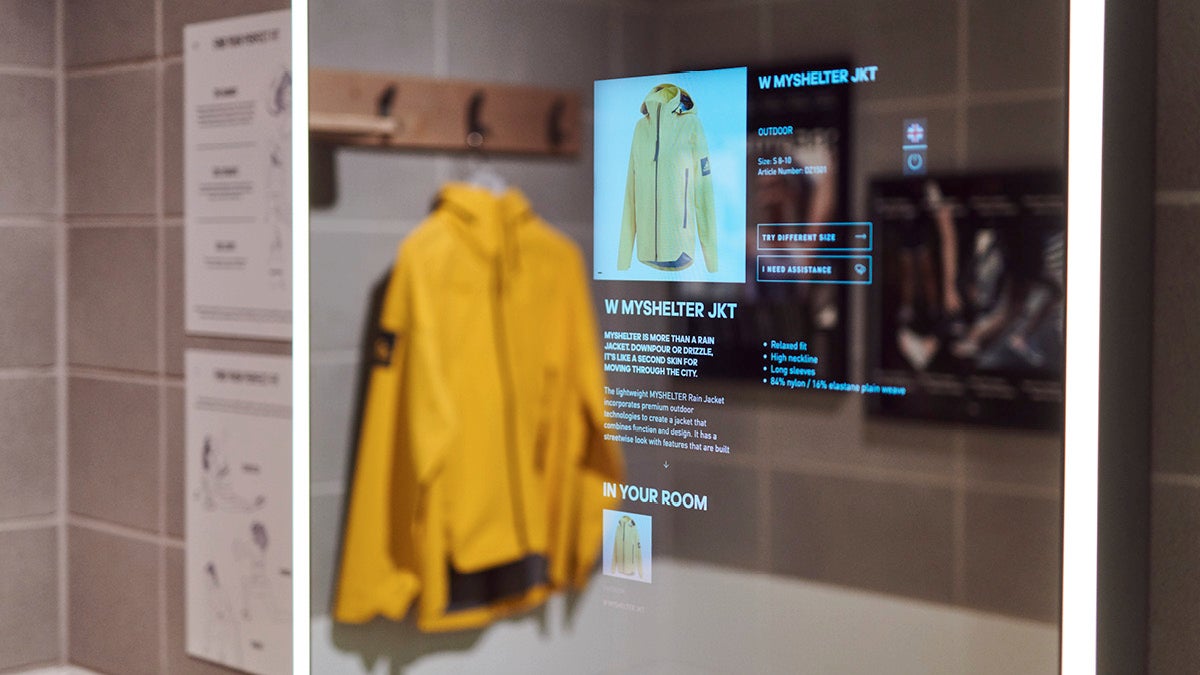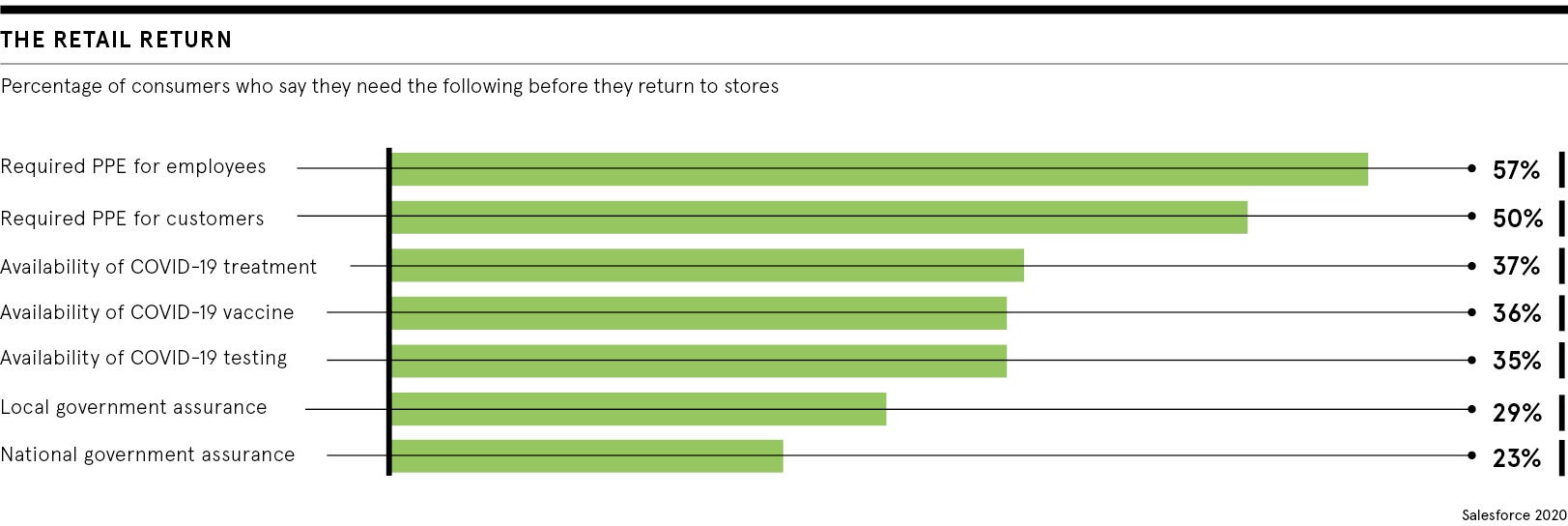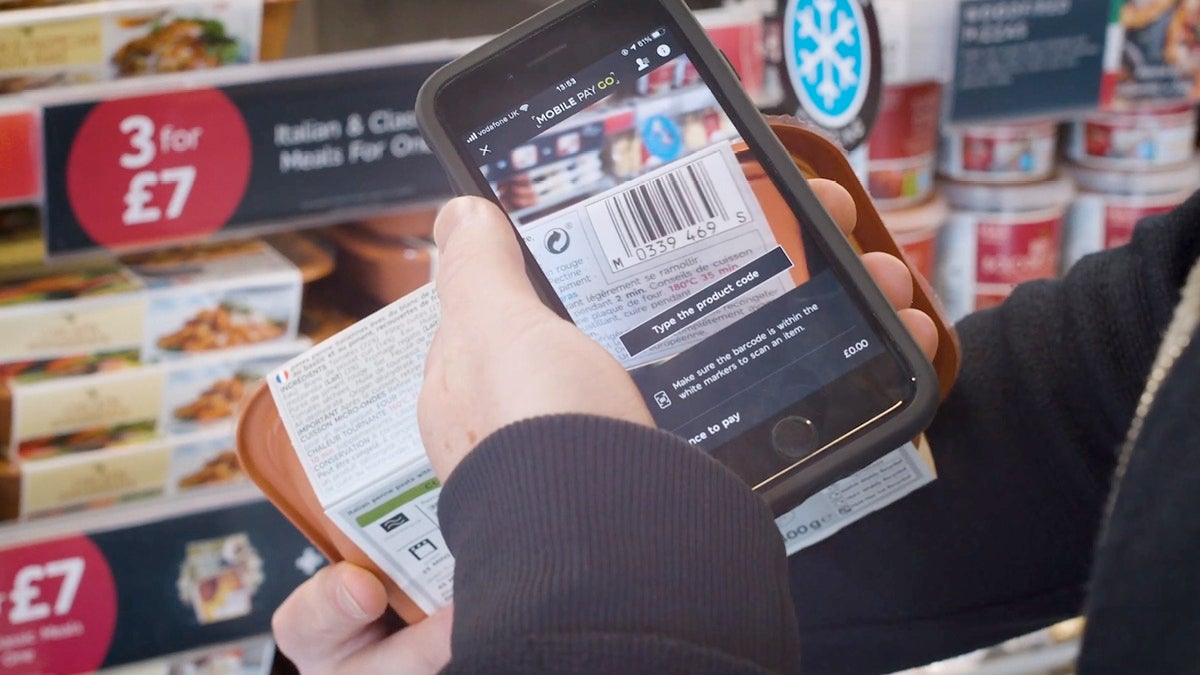The magnificent window display stops her in her tracks. A brilliant composition of theatrical brand values and a new collection; it’s experiential retail at its best. She smiles, before turning her attention to the product. “Gorgeous dress,” she thinks. She knows exactly what’s in stock and if it’s available in her size. Should she wish, a sales assistant awaits to offer advice. She takes the dress and two tops. Click. She puts her phone down.
Next week, she will visit her favourite shop in person, for a private appointment. And on her way, she’ll be stopped in her tracks once again, literally this time, to watch a film by a different brand, screened as a window display.
It’s 2021 and the coronavirus continues to circulate, leaving behind it a trail of closed bricks-and-mortar stores. Some have disappeared from the high street, others have downsized their portfolios. But many are innovating by placing experiential retail, with a blend of digital and physical, at the forefront of their post-pandemic strategy.
“Many of the experiential elements of retail are becoming digital, while bricks and mortar evolves to serve some of the more functional aspects of shopping,” explains Alex Hawkins, senior foresight writer at consultancy The Future Laboratory.
“Brands and retailers are now starting to invest in digital design to create beautiful, dynamic and interactive virtual showrooms that recreate many of the immersive and experiential touchpoints we used to associate with the store. The role of sales associates is also being transformed to become virtual brand ambassadors.”
A blend of retail experiences
The most popular stores in 2021 will have blended the digital and the physical to perfection. At luxury fashion brand MATCHESFASHION, which has five stores in London, virtual private shopping appointments are proving very popular with its discerning, global shoppers.
“There remains, of course, an appetite to touch and feel the clothes, so physical visits remain available, in line with government guidelines,” says Jess Christie, chief brand and content officer.

Inside adidas’s flagship on Oxford Street, kitted out with interactive mirrors and instore geolocation tracking
“And [physical] private appointments are proving successful. Luxury customers want inspiration, immediacy and intimacy. We know many of our clients on a personal basis; they can quickly tell us how they would like their experience to be, including whether they would like to be accompanied, at a distance, as they browse.”
Fans of the sports giant adidas, which opened its LDN store on London’s Oxford Street in October 2019 – a shiny, bright example of experiential retail – continue to interact with more than 100 digital touchpoints and myriad immersive experiences, albeit in a more orderly way. The brand has maximised its app for augmenting the in-store experience.
“It has been developed further to allow consumers to set times for their [store] visit, reducing wait times outside and allowing more time experiencing our stores,” says Steven Woolley, senior director for adidas’s retail operations.
Streamlining experiences in bricks-and-mortar stores
Customers at Marks & Spencer, meanwhile, quickly buy their groceries in stores without visiting a till by using the retailer’s Mobile Pay Go app on their smartphones. Sarah Cokayne, head of retail support services, says M&S has seen a significant move towards contact-free shopping during the pandemic.
“Over 10,000 new regular users of Mobile Pay Go have come on board since March 2020; this technology will only continue to progress. Digitally connected stores are more important now than ever before,” she says. M&S has tripled its Mobile Pay Go network from 100 to 310 stores this summer.

In M&S’s footwear department, shoppers carry a print-out of a measuring guide or consult the guide on their phones. M&S sells a quarter of a million school shoes each year, but it cannot offer an in-store shoe-fitting service in a socially distanced environment.
“The team created a bespoke measuring guide which customers can easily access on their phone in-store or they can use a print-out. It’s one small example of how we’ve adapted our offering; something we’ll continue to do,” Cokayne adds.
Retail spaces and technology
For all the technological prowess of certain brands, many consumers still miss being able to try on clothes after lockdown was lifted; not all retailers can offer private appointments. But augmented reality (AR) is helping to replicate that experience.
Tech that allows customers to shop and pay quickly has gone from being a nice to have to a necessity
“Done well, AR gives shoppers the confidence to buy online knowing that an item of clothing is likely to suit their body shape or size and it can reduce return rates,” says Kirsty McGregor, editor of fashion business magazine Drapers.
“However, it is expensive to implement and already-tight retail budgets have been squeezed by the pandemic, so it is still not widely used. But technology that allows customers to shop and pay quickly, such as self-checkout and mobile pay options, has gone from being a nice-to-have to a necessity.”
Customers feel safer now, too, thanks to improved technology in bricks-and-mortar stores. Both adidas and M&S have developed their respective apps to count the number of shoppers in stores, in real time. M&S’s was initially created in just three days, demonstrating the retailer’s ability to react quickly to unprecedented changes.

Customers at Marks & Spencer can buy groceries without visiting a till by using the retailer’s Mobile Pay Go app
“Our counting app allows colleagues to count the number of customers into store and can be used simultaneously by colleagues on different doors,” Cokayne explains. “Managing the flow of customers in and out is a really important part of helping our customers shop with confidence.”
Engaging with customers through physical retail
While safety remains a concern, 2021 could see a shift back to creating unique, fun and experiential retail experiences. “Shoppers can expect a more localised and personal approach, with improved customer service, particularly from high street chains,” says McGregor.
Retailers are also using their physical stores to emphasise brand values, notably when it comes to sustainability and diversity. “The pandemic has made people reflect on their purchasing decisions,” McGregor adds. “Fashion brands can use bricks-and-mortar stores to demonstrate their values reflect those of their customers, such as Timberland’s ‘purpose-led’ flagship store on Carnaby Street.”
Timberland’s 2,594-sq-ft space brings the brand’s corporate social responsibility strategy to life with living trees and towering pillars referencing the brand’s use of recycled materials, community projects and overall creative vision.

The theatrics of a bricks-and-mortar store remain pivotal for a brand like adidas too. “We have been deepening our relationship with local artists through store events and locally relevant products, to connect our store spaces and provide an experience for people with the kind of human connection they have been missing,” says Woolley.
“Whether it’s through augmented reality versions of our new ZX Boost sneaker or showcasing speed for our new X Ghosted football boot, our stores are there to excite and engage.”
Exciting new uses for bricks-and-mortar stores
At the other end of the spectrum, bricks-and-mortar stores are performing another important role: function. “Stores are being transformed into logistics hubs as click-and-collect culture becomes the norm, with retail brands considering how logistics hubs can become destinations in and of themselves,” says The Future Laboratory’s Hawkins.
Stores are becoming spaces for brand-broadcasting, as they are utilised to create their own social media and marketing content
“Before the pandemic, brands were already experimenting with creating in-store studios to attract YouTubers and influencers. Now, stores are becoming spaces for brand-broadcasting, as they are utilised to create their own social media and marketing content.”
There’s a school of thought that says out of difficult times comes moments of clarity, bursts of creativity. For some, COVID-19 was an insurmountable challenge. For others, it pushed them to innovate. People have an immense capacity for change and that includes our capacity for shopping in very different ways.
A blend of retail experiences

Streamlining experiences in bricks-and-mortar stores

